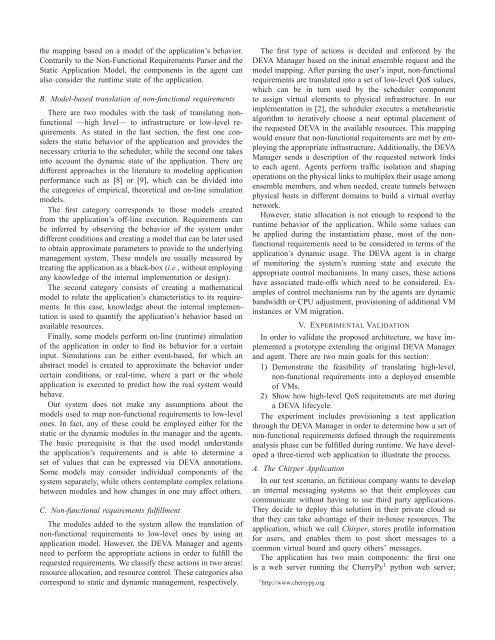Mapping Non-Functional Requirements to Cloud Applications
Mapping Non-Functional Requirements to Cloud Applications
Mapping Non-Functional Requirements to Cloud Applications
Create successful ePaper yourself
Turn your PDF publications into a flip-book with our unique Google optimized e-Paper software.
the mapping based on a model of the application’s behavior.<br />
Contrarily <strong>to</strong> the <strong>Non</strong>-<strong>Functional</strong> <strong>Requirements</strong> Parser and the<br />
Static Application Model, the components in the agent can<br />
also consider the runtime state of the application.<br />
B. Model-based translation of non-functional requirements<br />
There are two modules with the task of translating nonfunctional<br />
—high level— <strong>to</strong> infrastructure or low-level requirements.<br />
As stated in the last section, the first one considers<br />
the static behavior of the application and provides the<br />
necessary criteria <strong>to</strong> the scheduler, while the second one takes<br />
in<strong>to</strong> account the dynamic state of the application. There are<br />
different approaches in the literature <strong>to</strong> modeling application<br />
performance such as [8] or [9], which can be divided in<strong>to</strong><br />
the categories of empirical, theoretical and on-line simulation<br />
models.<br />
The first category corresponds <strong>to</strong> those models created<br />
from the application’s off-line execution. <strong>Requirements</strong> can<br />
be inferred by observing the behavior of the system under<br />
different conditions and creating a model that can be later used<br />
<strong>to</strong> obtain approximate parameters <strong>to</strong> provide <strong>to</strong> the underlying<br />
management system. These models are usually measured by<br />
treating the application as a black-box (i.e., without employing<br />
any knowledge of the internal implementation or design).<br />
The second category consists of creating a mathematical<br />
model <strong>to</strong> relate the application’s characteristics <strong>to</strong> its requirements.<br />
In this case, knowledge about the internal implementation<br />
is used <strong>to</strong> quantify the application’s behavior based on<br />
available resources.<br />
Finally, some models perform on-line (runtime) simulation<br />
of the application in order <strong>to</strong> find its behavior for a certain<br />
input. Simulations can be either event-based, for which an<br />
abstract model is created <strong>to</strong> approximate the behavior under<br />
certain conditions, or real-time, where a part or the whole<br />
application is executed <strong>to</strong> predict how the real system would<br />
behave.<br />
Our system does not make any assumptions about the<br />
models used <strong>to</strong> map non-functional requirements <strong>to</strong> low-level<br />
ones. In fact, any of these could be employed either for the<br />
static or the dynamic modules in the manager and the agents.<br />
The basic prerequisite is that the used model understands<br />
the application’s requirements and is able <strong>to</strong> determine a<br />
set of values that can be expressed via DEVA annotations.<br />
Some models may consider individual components of the<br />
system separately, while others contemplate complex relations<br />
between modules and how changes in one may affect others.<br />
C. <strong>Non</strong>-functional requirements fulfillment<br />
The modules added <strong>to</strong> the system allow the translation of<br />
non-functional requirements <strong>to</strong> low-level ones by using an<br />
application model. However, the DEVA Manager and agents<br />
need <strong>to</strong> perform the appropriate actions in order <strong>to</strong> fulfill the<br />
requested requirements. We classify these actions in two areas:<br />
resource allocation, and resource control. These categories also<br />
correspond <strong>to</strong> static and dynamic management, respectively.<br />
The first type of actions is decided and enforced by the<br />
DEVA Manager based on the initial ensemble request and the<br />
model mapping. After parsing the user’s input, non-functional<br />
requirements are translated in<strong>to</strong> a set of low-level QoS values,<br />
which can be in turn used by the scheduler component<br />
<strong>to</strong> assign virtual elements <strong>to</strong> physical infrastructure. In our<br />
implementation in [2], the scheduler executes a metaheuristic<br />
algorithm <strong>to</strong> iteratively choose a near optimal placement of<br />
the requested DEVA in the available resources. This mapping<br />
would ensure that non-functional requirements are met by employing<br />
the appropriate infrastructure. Additionally, the DEVA<br />
Manager sends a description of the requested network links<br />
<strong>to</strong> each agent. Agents perform traffic isolation and shaping<br />
operations on the physical links <strong>to</strong> multiplex their usage among<br />
ensemble members, and when needed, create tunnels between<br />
physical hosts in different domains <strong>to</strong> build a virtual overlay<br />
network.<br />
However, static allocation is not enough <strong>to</strong> respond <strong>to</strong> the<br />
runtime behavior of the application. While some values can<br />
be applied during the instantiation phase, most of the nonfunctional<br />
requirements need <strong>to</strong> be considered in terms of the<br />
application’s dynamic usage. The DEVA agent is in charge<br />
of moni<strong>to</strong>ring the system’s running state and execute the<br />
appropriate control mechanisms. In many cases, these actions<br />
have associated trade-offs which need <strong>to</strong> be considered. Examples<br />
of control mechanisms run by the agents are dynamic<br />
bandwidth or CPU adjustment, provisioning of additional VM<br />
instances or VM migration.<br />
V. EXPERIMENTAL VALIDATION<br />
In order <strong>to</strong> validate the proposed architecture, we have implemented<br />
a pro<strong>to</strong>type extending the original DEVA Manager<br />
and agent. There are two main goals for this section:<br />
1) Demonstrate the feasibility of translating high-level,<br />
non-functional requirements in<strong>to</strong> a deployed ensemble<br />
of VMs.<br />
2) Show how high-level QoS requirements are met during<br />
a DEVA lifecycle.<br />
The experiment includes provisioning a test application<br />
through the DEVA Manager in order <strong>to</strong> determine how a set of<br />
non-functional requirements defined through the requirements<br />
analysis phase can be fulfilled during runtime. We have developed<br />
a three-tiered web application <strong>to</strong> illustrate the process.<br />
A. The Chirper Application<br />
In our test scenario, an fictitious company wants <strong>to</strong> develop<br />
an internal messaging systems so that their employees can<br />
communicate without having <strong>to</strong> use third party applications.<br />
They decide <strong>to</strong> deploy this solution in their private cloud so<br />
that they can take advantage of their in-house resources. The<br />
application, which we call Chirper, s<strong>to</strong>res profile information<br />
for users, and enables them <strong>to</strong> post short messages <strong>to</strong> a<br />
common virtual board and query others’ messages.<br />
The application has two main components: the first one<br />
is a web server running the CherryPy 1 python web server;<br />
1 http://www.cherrypy.org
















